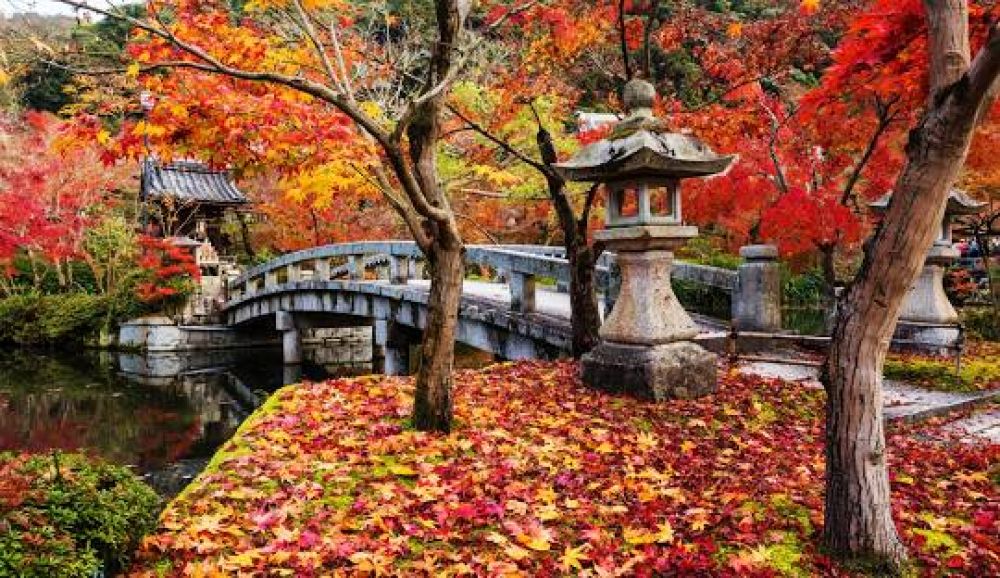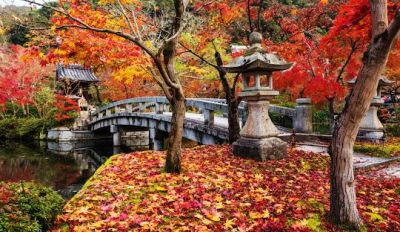

Eikando Zenrinji Temple, also known as Eikan-do, becomes a particularly popular destination during the autumn season when the temple's numerous maples turn brilliant shades of red and orange. Visitors can enjoy a leisurely stroll through the temple grounds that are illuminated by the vibrant colors of the fall foliage. This breathtaking natural tapestry creates a serene and enchanting atmosphere that perfectly complements the spiritual setting of the temple. The historical structures, including the famous pagoda and the Tahoto tower, provide a striking contrast against the autumnal palette of the surrounding trees. During this season, the temple often extends its hours into the evening, offering a special nighttime illumination event that allows guests to experience the magical ambiance of the foliage under the soft glow of lanterns and spotlights.
The Zazen meditation experience at Eikando Temple offers a rare chance for visitors to engage with the practices of Japanese Zen Buddhism in an authentic setting. Zazen, which means 'seated meditation,' is a meditative discipline intended to calm the body and the mind, allowing for deep introspection and mindfulness. Participants will sit on cushions in the serene environment of the temple's meditation hall and receive guidance from experienced monks. This practice allows individuals to escape the bustle of daily life and connect with their spiritual selves. The session includes an introduction to the principles of Zen, the correct posture for meditation, and a period of silent contemplation. This form of meditation can be a profound and transformative experience that provides insights into the Buddhist way of life.
Eikando Temple is not only a place of worship but also a center for cultural and educational exchange. The temple hosts a series of lectures that delve into various aspects of Japanese culture, history, and religion. These talks are often conducted by scholars or monks who are experts in their fields and provide deep insights into topics such as Zen Buddhism, the history of Eikando itself, and the role of temples in Japanese society. The lectures are a fantastic opportunity for visitors who are keen to expand their understanding of Japan's rich cultural heritage. Participants are encouraged to engage with the material through questions and discussions, making this an interactive and enlightening experience. These events are held in designated areas within the temple grounds and may include multimedia presentations or demonstrations.
Eikando Temple boasts exquisite Japanese gardens, with carefully designed landscapes that harmonize with the natural surroundings. A guided tour of the gardens and pond allows visitors to appreciate the meticulous attention to detail evident in the garden's design. Landscaped over the centuries, these gardens are a testament to the Japanese aesthetic of wabi-sabi, embracing simplicity, naturalness, and the beauty of imperfection. The centerpiece of the garden is the large pond named Hojo-ike, which reflects the temple structures and the changing seasonal colors. The tour guide will explain the significance of various plant species, rock formations, and water features, all of which are integral to the spiritual and aesthetic experience. The tours reveal the cultural importance of gardening in Japan and offer insight into the philosophical principles guiding its practice.
The tea ceremony is a cherished cultural activity in Japan, and Eikando Temple offers visitors the opportunity to partake in this unique tradition. This highly choreographed ritual of preparing and serving matcha (powdered green tea) is steeped in Zen principles and emphasizes mindfulness, hospitality, and the appreciation of beauty in simplicity. During the tea ceremony experience, guests are invited to enter a traditional tea house or designated area within the temple grounds. A tea master will demonstrate the elaborate process of making the tea while imparting knowledge about its history and the associated etiquette. Participants will then have the chance to savor the whisked green tea accompanied by a traditional Japanese sweet, creating a moment of peace and reflection. This activity exemplifies a cultural practice that has been refined over centuries in Japan.
Japanese calligraphy, or 'shodo,' is an art form that combines visual art with literary meaning. Eikando Temple hosts calligraphy workshops where visitors can try their hand at this traditional craft under the guidance of a skilled calligrapher. Participants learn how to handle the brush and ink to create their own piece of calligraphy, such as writing their name or a simple Japanese phrase in kanji characters. The calligraphy workshop provides a tangible connection to Japanese culture as participants learn about the significance of the written word and the precision and expression involved in this art. Calligraphy workshops are typically held in a quiet and contemplative space within the temple to ensure a peaceful and focused environment for learning this meditative practice.
Eikando Temple has a rich history dating back to the Heian period, and a guided historical tour of the temple grounds and buildings allows visitors to immerse themselves in its storied past. These tours provide an overview of the temple's origins, including important cultural artifacts and structures such as the Eikando Pagoda and the Mikaeri-Amida statue, for which the temple is renowned. A knowledgeable guide explains the significance of each feature, sharing stories and anecdotes that bring the temple's history to life. Tour participants will learn about the practices and individuals that have shaped Eikando Temple over the centuries, including key historical figures associated with the temple. The combination of historical narrative with the beauty of the temple's architecture and artwork makes this tour a must-do for history buffs and those interested in the evolution of Zen Buddhism in Japan.
The morning prayer service at Eikando Temple is an opportunity for visitors to observe or participate in the daily rituals of Zen Buddhist worship. This early morning service is conducted by the resident monks and includes chanting, drumming, and offering incense. Those attending the service can experience the spiritual atmosphere and the routine that monks have followed for generations. The rhythmic sound of the chanting and the fragrance of the incense create a calming and meditative ambience. Visitors are welcome to sit quietly and respectfully during the service, absorbing the tranquility and participating at their comfort level. Attending the morning prayer service can provide a sense of peace and help set a reflective tone for the rest of the day. It's a rare chance to witness the living traditions of Zen Buddhism within the walls of an ancient temple.
Throughout the year, Eikando Temple hosts various festivals and seasonal events that celebrate the ebb and flow of the year. These may include the cherry blossom festival in spring when the temple ground's numerous cherry trees burst into bloom, casting a delicate pink hue over the landscape. Summertime may include traditional Bon Odori dances related to the Obon festival, where participants can join in dances to honor the spirits of their ancestors. In the winter, there might be special lighting or ceremonies to commemorate the New Year. Each festival includes a variety of activities such as special prayers, cultural performances, and food stalls offering traditional Japanese cuisine. These festivals are times of joy and community and offer a vibrant and engaging way to experience the customs and traditions that underpin Japanese cultural life.
For photography enthusiasts, Eikando Temple offers a rich tapestry of scenes to capture on camera. A photography tour can help visitors find the ideal spots to take pictures of the temple's historic buildings, stunning gardens, and the surrounding nature throughout the seasons. Under the guidance of a photography-savert guide, participants will learn about composition, lighting, and other techniques to best capture the essence of Eikando. Spring brings the soft colors of cherry blossoms, while autumn offers fiery maple leaves, each providing ample inspiration. Not only will the tour teach practical photography skills, but it also provides a deeper understanding of the site's cultural and aesthetic importance. Whether an amateur or experienced photographer, participants will leave with a collection of memorable photographs that convey the beauty and ambiance of Eikando Temple.
